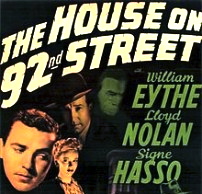The House on 92nd Street

The House on 92nd Street 1945
Espionage film from 1945.
The House on 92nd Street is a 1945 black-and-white American spy film directed by Henry Hathaway. The film, shot mainly in New York City, was released shortly after the end of World War II. The House on 92nd Streetwas made with the full cooperation of the Federal Bureau of Investigation (FBI), and its head, J. Edgar Hoover, appears during the introduction. Also, the FBI agents in Washington were played by actual agents. The film’s semidocumentary style inspired other films including The Naked City.
Plot
In 1939, American standout university student Bill Dietrich (William Eythe) is approached by Nazi recruiters due to his German heritage. He feigns interest, then notifies the FBI. FBI agent George Briggs (Lloyd Nolan) tells him to play along.
Dietrich travels to Hamburg, Germany, where he undergoes six months of intensive training in espionage. He is then sent back to the United States to set up a radio station and to act as paymaster to the spies already there. He is told that only a “Mr. Christopher” has the authority to change his assignment.
Dietrich manages to pass along his microfilmed credentials to the FBI; they are altered so that instead of being forbidden to contact most of the agents, he is authorized to meet them all. In New York, his contact, dress designer Elsa Gebhardt (Signe Hasso), is suspicious of the modification and requests confirmation from Germany, but communication is slow. In the meantime, she has no choice but to give Dietrich full access to her spy ring. When questioned, Dietrich’s other legitimate contact, veteran espionage agent Colonel Hammersohn (Leo G. Carroll), denies knowing Mr. Christopher’s identity.
In a separate development, a German spy is killed in a traffic accident; the FBI finds a secret message among his possessions stating that Mr. Christopher will concentrate on Process 97. Briggs is alarmed because he is aware that Process 97 is America’s most closely guarded secret.
When the Japanese attack Pearl Harbor in December 1941, the United States enters the war. Most of the spies Dietrich has identified are immediately picked up, but Gebhardt’s ring is left alone, in the hope of flushing out Mr. Christopher.
Gebhardt gives Dietrich papers to transmit immediately to Germany; they contain part of Process 97, a key part of the atomic bomb project. Dietrich steals a cigarette butt he notices in non-smoker Gebhardt’s otherwise empty ashtray. The FBI traces this tiny clue to Luise Vadja, and from her to her supposed boyfriend, Charles Ogden Roper (Gene Lockhart), a scientist working on the atomic bomb. Roper breaks when he is picked up and shown a message from Germany ordering his liquidation after he has completed his mission. Roper confesses to dropping off the last part of Process 97 at a bookstore, hiding the papers in a book. A man believed to be Mr. Christopher is filmed leaving the store. That is enough for Briggs. He orders the arrest of Gebhardt’s ring.
It is just in time for Dietrich. Gebhardt finally receives a reply from Germany, confirming her worst fears. She injects Dietrich with scopolamine in an attempt to obtain information, but her building is surrounded by government agents. Gebhardt orders her underlings to hold them off while she disguises herself as a man – she is Mr. Christopher – and tries to escape with the vital papers. Unable to get away, she returns, only to be shot by mistake by one of her own men. The rest are captured, and Dietrich rescued.
Cast
- William Eythe as Bill Dietrich
- Lloyd Nolan as Agent George A. Briggs
- Signe Hasso as Elsa Gebhardt
- Gene Lockhart as Charles Ogden Roper
- Leo G. Carroll as Col. Hammersohn
- Lydia St. Clair as Johanna Schmidt, part of Gebhardt’s ring
- William Post Jr. as Walker (as William Post)
- Harry Bellaver as Max Cobura, one of Gebhardt’s spies
- Bruno Wick as Adolf Lange, owner of the bookstore
- Harro Meller as Conrad Arnulf, another of Gebhardt’s agents
- Charles Wagenheim as Gustav Hausmann
- Alfred Linder as Adolf Klein
- Renee Carson as Luise Vadja
- E.G. Marshall as Attendant at Morgue
- Elisabeth Neumann-Viertel as Freda Kassel
- Sheila Bromley as Beauty Parlor Customer
Production and Background
The House on 92nd Street is the first film noir produced by Louis De Rochemont, credited as a pioneer of the semidocumentary style police thriller.
The film is also a thinly disguised version of the FBI’s real-life Duquesne Spy Ring saga of 1941, the largest convicted espionage case in the history of the United States. On January 2, 1942, 33 Nazi spies, including the ring leader Fritz Joubert Duquesne (also known as “The man who killed Kitchener“), were sentenced to more than 300 years in prison. One German spymaster later commented that the ring’s roundup delivered ‘the death blow’ to their espionage efforts in the United States. J. Edgar Hoover called his concerted FBI swoop on Duquesne’s ring the greatest spy roundup in U.S. history.
Lloyd Nolan would reprise his role as Inspector Briggs in the sequel, The Street with No Name (1948). In that film, Briggs and the FBI agents would take on organized crime.
Reception – Critical Response
Thomas M. Pryor, film critic for The New York Times wrote, “The House on Ninety-second Street barely skims the surface of our counterespionage operations, but it reveals sufficient of the FBI’s modus operandi to be intriguing on that score alone.”
Although praised when released in 1945, the film when released on DVD in 2005 received mostly mixed reviews. Christopher Null, writing for Filmcritic.com, writes, “today it comes across as a bit goody-goody, pandering to the FBI, pedantic, and not noirish at all.”
Accolades
Wins
- Oscar: Original Motion Picture Story — Charles G. Booth; 1946.
- Edgar Award: from the Mystery Writers of America for Best Motion Picture Screenplay – Charles G. Booth, Barre Lyndon, John Monks, Jr; 1945.


